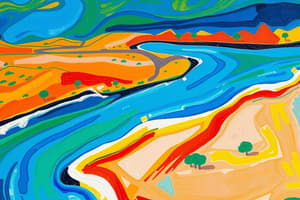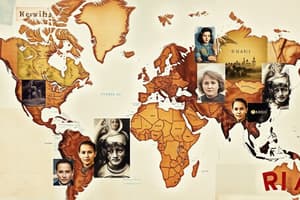Podcast
Questions and Answers
What is the capital of Kenya and its largest city?
What is the capital of Kenya and its largest city?
- Nairobi (correct)
- Eldoret
- Mombasa
- Kisumu
Land pollution can lead to a decrease in fertile land for agriculture?
Land pollution can lead to a decrease in fertile land for agriculture?
True (A)
Name three types of river sources.
Name three types of river sources.
Glacial headwaters, spring sources, and precipitation runoff.
Food exporting is the process of sending food products from one country to be sold in ______ country.
Food exporting is the process of sending food products from one country to be sold in ______ country.
Match the type of pollution with one of its effects:
Match the type of pollution with one of its effects:
Which of the following is NOT a way to manage Air Pollution?
Which of the following is NOT a way to manage Air Pollution?
Reforestation is a method of managing water pollution.
Reforestation is a method of managing water pollution.
Explain what food exporting is.
Explain what food exporting is.
Which of the following is a positive impact of food exporting?
Which of the following is a positive impact of food exporting?
Coastal buildings are not at risk of damage from storm surges.
Coastal buildings are not at risk of damage from storm surges.
Name one threat to the coastal environment.
Name one threat to the coastal environment.
During the process of __________, water absorbs heat energy and transforms from a liquid to a gaseous state.
During the process of __________, water absorbs heat energy and transforms from a liquid to a gaseous state.
Which process describes water vapor turning back into liquid water and forming clouds?
Which process describes water vapor turning back into liquid water and forming clouds?
Erosion is not a danger for coastal buildings.
Erosion is not a danger for coastal buildings.
What is a negative impact of food exporting that can lead to increased food prices globally?
What is a negative impact of food exporting that can lead to increased food prices globally?
Match the following stages of the water cycle with their descriptions:
Match the following stages of the water cycle with their descriptions:
Which of the following is NOT a primary way mountains are formed?
Which of the following is NOT a primary way mountains are formed?
A mountain range is a group of mountains that are not connected to each other.
A mountain range is a group of mountains that are not connected to each other.
What is the height of Mount Everest?
What is the height of Mount Everest?
Which of the following is NOT considered to be part of the Himalayan mountain range
Which of the following is NOT considered to be part of the Himalayan mountain range
A ____ mountain is formed by tectonic forces that cause the Earth's crust to fracture, and they mostly don't have mountain peaks.
A ____ mountain is formed by tectonic forces that cause the Earth's crust to fracture, and they mostly don't have mountain peaks.
Match the term to its definition:
Match the term to its definition:
Which of the following is NOT mentioned as being a feature of the Andes Mountains?
Which of the following is NOT mentioned as being a feature of the Andes Mountains?
What is a volcano?
What is a volcano?
What is the definition of a mountain?
What is the definition of a mountain?
Rivers are only useful for transportation.
Rivers are only useful for transportation.
What is left behind after a river flood?
What is left behind after a river flood?
Rivers of ice are called ______.
Rivers of ice are called ______.
Match the following rivers to the associated regions:
Match the following rivers to the associated regions:
Which of the following is NOT a major challenge faced by Rio de Janeiro?
Which of the following is NOT a major challenge faced by Rio de Janeiro?
What are the main islands of Japan?
What are the main islands of Japan?
Mountains are not useful to humans
Mountains are not useful to humans
Flashcards
River Mouth
River Mouth
The point where a river enters the sea.
Sea
Sea
A large body of salt water, often connected to an ocean.
Meander
Meander
A bend or curve in a river's course.
Tributary
Tributary
Signup and view all the flashcards
Floodplain
Floodplain
Signup and view all the flashcards
Estuary
Estuary
Signup and view all the flashcards
Waterfall
Waterfall
Signup and view all the flashcards
Volcanic Mountain
Volcanic Mountain
Signup and view all the flashcards
What is a mountain?
What is a mountain?
Signup and view all the flashcards
Fold mountain ranges
Fold mountain ranges
Signup and view all the flashcards
What are glaciers?
What are glaciers?
Signup and view all the flashcards
Why were rivers important to early civilizations?
Why were rivers important to early civilizations?
Signup and view all the flashcards
Which river is associated with Egypt?
Which river is associated with Egypt?
Signup and view all the flashcards
Urban sprawl in Rio de Janeiro
Urban sprawl in Rio de Janeiro
Signup and view all the flashcards
What language is taught in Rio de Janeiro schools?
What language is taught in Rio de Janeiro schools?
Signup and view all the flashcards
What is a major problem in Kenya?
What is a major problem in Kenya?
Signup and view all the flashcards
Food Exporting
Food Exporting
Signup and view all the flashcards
Glacial Headwaters
Glacial Headwaters
Signup and view all the flashcards
Spring Sources
Spring Sources
Signup and view all the flashcards
Precipitation Runoff
Precipitation Runoff
Signup and view all the flashcards
Water Pollution
Water Pollution
Signup and view all the flashcards
Land Pollution
Land Pollution
Signup and view all the flashcards
Air Pollution
Air Pollution
Signup and view all the flashcards
Acid Rain
Acid Rain
Signup and view all the flashcards
Increased global food security
Increased global food security
Signup and view all the flashcards
Economic benefits for exporting countries
Economic benefits for exporting countries
Signup and view all the flashcards
Potential for price volatility
Potential for price volatility
Signup and view all the flashcards
Possible negative health effects
Possible negative health effects
Signup and view all the flashcards
Flooding and storm surge
Flooding and storm surge
Signup and view all the flashcards
Erosion
Erosion
Signup and view all the flashcards
Pollution
Pollution
Signup and view all the flashcards
Coastal development
Coastal development
Signup and view all the flashcards
Study Notes
Semester 1 Midterm Exam Guide
- Exam will cover 8 sections
- Section 1: True or False (Focus: Mountains)
- Section 2: Fill in the blanks (Focus: Rivers)
- Section 3: Matching (Focus: Pollution)
- Section 4: Long answer question (Focus: Water cycle)
- Section 5: Multiple choice (Focus: Cities)
- Section 6: Short answer questions (Focus: Open-ended questions)
- Section 7: Matching diagram (Focus: Rivers)
- Section 8: Analysis and answer questions (Focus: Pollution)
- Total marks: 60
Extra Practice Questions
- Definition of a mountain: A large natural elevation of the Earth's surface.
- Fold mountain range examples: Rocky Mountains, Himalayas, Andes (both b and c are correct).
- Rivers of ice: Icebergs
- High-altitude mountain vegetation: Grasses, mosses, and lichens.
- Human use of mountains: A storehouse of water.
- River importance to early civilizations: Providing water for irrigation and fertile soil.
Additional Questions
- River associated with Egypt: The Nile River
- River flood residue: Mud
- River impact on early settlements: Providing water for irrigation and supporting farming.
- River flowing through Ireland: River Lee
- Rio de Janeiro major challenges: Not urban sprawl, air pollution, waste disposals (overpopulation in rural areas).
- Rio de Janeiro primary language: Portuguese.
- Major problem in Kenya: Urban migration.
- Main islands of Japan: Hokkaido, Honshu, Shikoku (All of the above)
Vocabulary List
- Source: Where a river begins
- Meander: A bend in a river
- Narrow: Thin or not wide
- Waterfall: A vertical drop in a river.
- Fast: Moving quickly
- Steep: Having a sharp slope or incline
- Floodplain: A flat area of land next to a river
- Estuary: Mixing fresh and salt water when a river meets the sea
- Flat: Level or even surface
- Flatter: Landscapes that promote meandering
- Mouth: Where a river enters the sea
- Sea: A large body of salt water
- Tributary: A smaller river flowing into a larger one
- Eruption: Sudden, violent outburst (volcanic)
- Volcano: A mountain with an opening for lava, rock, and gas
Mountain Formation and Types
- Tectonic plate collision: Forms mountain ranges from rock forced upwards
- Lava flow: Creates volcanic mountains when magma cools and hardens on the Earth's surface
- Mountain range definition: A connected group of mountains, found on land
- Mount Everest facts (2): 8,848.86 meters high, grows each year.
- Himalayas facts (2): Formed by tectonic plates, located in multiple countries (India, China, Nepal, Bhutan, Pakistan, and Afghanistan).
- Andes Mountains facts (2): The world's longest continental mountain range, extending 8,900 km, has unique features such as the Atacama desert and Lake Titicaca.
Locations and Differences
- Location of mountains: All continents
- Stand-alone mountain: Individual peak not part of a range
- Mountain range: Series of connected mountains in a line
- Block mountain: Formed by tectonic forces fracturing the Earth's crust.
Facts about Specific Locations
- Kenya location/population: East Africa; 6-44 million people
- Kenya's capital city: Nairobi
- Kenya ecosystem attributes: Diverse ecosystems, known national park
Pollution Effects
- Water pollution effects (3): Ecosystem damage, food chain disruption, spread of waterborne diseases, contamination of drinking water affecting long-term health.
- Land pollution effects (3): Soil and water contamination, reduced fertile land, increased human health issues, climate change effects (flooding, rainfall).
- Air pollution effects (3): Respiratory problems, contribution to climate change (through greenhouse gases), and acid rain formation damaging forests, crops, and aquatic life.
Pollution Management
- Water pollution management (2): Implement wastewater treatment systems, promote eco-friendly detergents and organic fertilizers.
- Land pollution management (2): Practice reforestation, Implement solid waste treatments
- Air pollution management (2): Encourage energy-efficient technologies, install converters in vehicles to reduce emissions.
River Source Types
- Glacial headwaters: Formed by melting glacial ice
- Spring sources: Groundwater emerging at the surface
- Precipitation runoff: Rain or snowmelt flowing downhill
Food Exporting
- Food exporting definition: Sending food products from one country to be sold in another nation.
- Positive impacts of food exporting (2): Increased global food security and Economic benefits for exporting countries.
- Negative impacts of food exporting (2): Potential for price volatility and possible negative health effects.
- Coastal dangers (2): flooding and storm surge and erosion.
Water Cycle
- Evaporation: Water heated by the sun turns into vapor
- Condensation: Water vapor cools, forming clouds
- Precipitation: Water falls as rain, snow, hail
- Collection: Water gathers in bodies like rivers, oceans, lakes.
- 4 major steps of the water cycle: Evaporation, condensation, precipitation, and collection.
Coastal Environment Threats
- Coastal pollution: Industrial pollution (chemical runoff, heavy metals)
- Coastal development: Tourism, urbanization, and industry negatively affecting the coastal environment, leading to erosion.
Studying That Suits You
Use AI to generate personalized quizzes and flashcards to suit your learning preferences.




